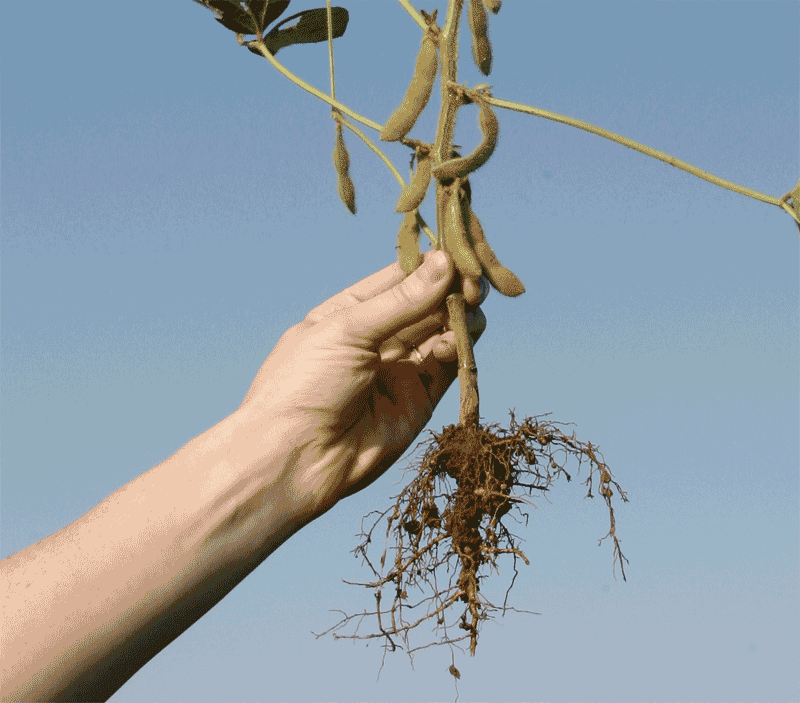Global agricultural research
CHALLENGES AND OPPORTUNITIES FROM CHINA
As a Research Coordinator at Grain Farmers of Ontario, Josh Cowan travelled to Beijing, China at the end of August to participate in both the International Congress of Plant Pathology and the Global Root Health Forum. Here, he shares some of the challenges farmers are facing and what the research community is doing to find solutions.
A NATION THAT is home to 20 percent of the world’s population and is the largest producer of wheat, the second largest producer of corn, and the fourth largest producer of soybeans in the world is a suitable host for international agricultural conferences.
PHOTO: SOIL AND ROOT HEALTH ARE THEY KEY TO ADVANCEMENTS IN CROP PRODUCTION.

In contrast to Canada, where only two percent of the population lives on farms with an average size of 778 acres, about half of China’s 1.4 billion people live in rural areas where the average farm size is about two acres, although rapid urbanization is changing these statistics. The 2012 population estimate of the city of Beijing alone was 20.7 million and rising (compare that to Canada’s entire population of 35 million).
Agricultural production in China remains a challenge today with only about 85 percent self-sufficiency in soybeans, corn, wheat, and rice, with the least self-sufficiency in soybeans. The quality of the soil is poor in many areas, water resource availability is very low (with 70 percent of grain production depending on irrigation), and most of the increases in grain yields in China have been a result of increased inputs – so resource efficiency has been touted as a key target to improve.
It is hardly a surprise then, that sustainable agriculture has become a key research focus in China and agricultural research funding continues to increase in an effort to stabilize the food supply, increase farmer income and living quality, improve the ability to fight natural disasters, and protect the environment. Implementation of the results of this research will become even more important for China over the next few decades as demand for food in the country is expected to increase by 50 percent (an additional 200 million tonnes per year).
RESEARCH COLLABORATION
Participation in scientific meetings to acquire an awareness of the current and upcoming research environment for corn, soybean, and wheat research are critical to inform the annual research priorities that Grain Farmers of Ontario releases each year. The International Congress of Plant Pathology this year brought together hundreds of scientists and industry representatives to share new research results in the areas of bio-security, food safety, and plant pathology. Next generation solutions for disease control were topics Grain Farmers of Ontario targeted during the conference.
Key emerging developments included the application of precision agriculture to manage plant diseases more effectively, predicting soil-borne diseases as a pro-active management tool, improved understanding of the interactions among multiple soil organisms on disease, and a case to increase diversity throughout a cropping system in an effort to manage resistance development in pathogens and reduce widespread disease incidence.
Multi-national pesticide companies also shared their more recent pursuit of biological solutions to complement chemical options for disease control. Fungicide resistance risk is currently moderate to high for 75 percent of fungicides sold worldwide and the development of new chemistries is becoming more difficult. While still pursuing chemical solutions, their investment in coordinated chemical/biological disease management options is seen as the next level of disease control solutions for farmers.
ROOT HEALTH
The second week of the China trip was the Global Root Health Forum hosted by Syngenta. This forum brought together 128 participants from 25 countries to network, share root health research results, and discuss threats to root health as well as the opportunities and gaps for research.
The Forum was based around a comment from AD Rovira in 1990 estimating that 80 percent of all plant problems start with soil and root problems. Soil and root health research remains a complicated and expensive endeavor that is still in its infancy, but as technologies have improved for studying roots, the potential exists for significant advances in crop production.
Grain Farmers of Ontario has recognized the need and potential for this research and has ranked soil health as a top research priority. The threats to root health range from pathogens and nematodes to insects and abiotic stresses, and the bringing together of experts from several countries and fields of study facilitated productive discussions on research strategies to best improve our understanding and management of root health, with hope that these could lead to practical outcomes for growers in the years ahead.
These two conferences provided valuable insight into the global research environment pertaining to plant diseases and root health. As the research and development opportunities for corn, soybeans, and wheat continue to evolve, we look forward to the prospects ahead for Ontario and hope to take advantage of what we have learned in the past. •





















